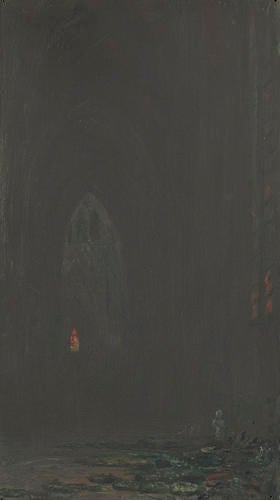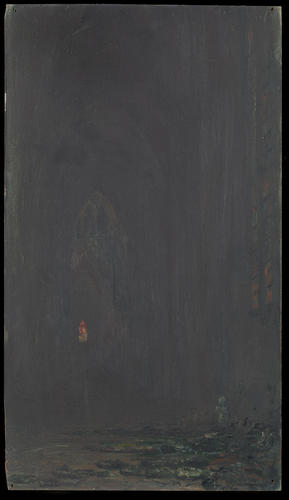-
1 of 253523 objects
Tennyson's Grave, Westminster Abbey Signed and dated 1892
Oil on panel | 32.0 x 17.4 cm (support, canvas/panel/stretcher external) | RCIN 403740

Georges Ricard-Cordingley (1873-1939)
Tennyson's Grave, Westminster Abbey Signed and dated 1892

Georges Ricard-Cordingley (1873-1939)
Tennyson's Grave, Westminster Abbey Signed and dated 1892


-
Widely recognised as a painter of portraits and historical subjects, Georges Ricard-Cordingley’s early career was defined by his seascapes, such as the pair in the Royal Collection, RCIN 406332 and 406333. During the early 1890s, the artist, who had been visiting a family friend in England, was introduced to Sir Henry Ponsonby (1825-95), Queen Victoria’s Private Secretary. Through him the monarch purchased three of Ricard-Cordingley’s works, and it is likely that these were Tennyson's Grave, and the forementioned seascapes.
The influence of his fellow-countryman, the landscape painter Jean Charles Cazin (1840-1901) is frequently evident in Ricard-Cordingley’s early works although paintings pertaining to his late career relate him to the Impressionists. His role as a stretcher-bearer during the First World War was the catalyst for the creation of several pictures depicting the realities of life on the Western Front.
A dark interior view of an aisle in Westminster Abbey, facing towards the apse. In the foreground, on the right, wreaths and tributes are placed against the wall in the centre of which is a bronze bust of the poet, Alfred, Lord Tennyson (1809-92).
Tennyson was the Poet Laureate for the latter half of Queen Victoria’s reign, succeeding William Wordsworth (1770-1850) upon his death. The monarch herself was an overt admirer of his work and, famously, of the elegy ‘In Memoriam A.H.H’ in particular.
Provenance
First recorded at Osborne House 1904
-
Creator(s)
-
Medium and techniques
Oil on panel
Measurements
32.0 x 17.4 cm (support, canvas/panel/stretcher external)
54.8 x 41.6 x 9.2 cm (frame, external)